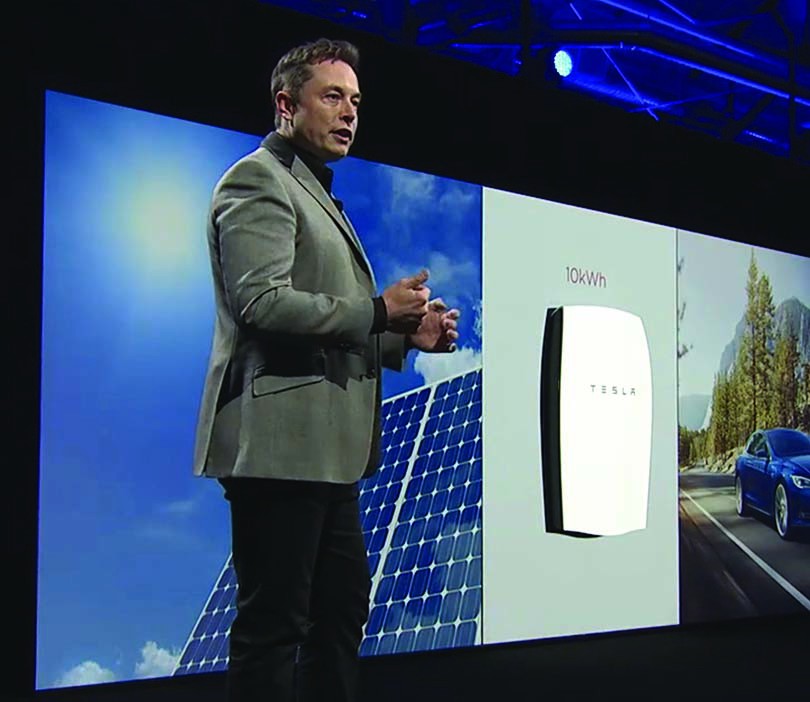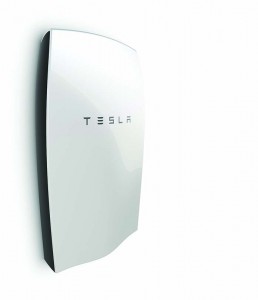Could a battery in your house change the electricity industry?
By Paul Wesslund
The latest energy gizmo is a battery, about as big as a medium-size flat-screen television, that looks good enough to hang on a wall in your home. It could supply backup electricity during a power outage. Or, if you are someone with photovoltaic cells on your roof, you could charge it from the sun during the day, then run your home at night on stored solar energy.
While this battery will be too expensive for most of us to want in our homes anytime soon, it could lead to innovations in the electricity industry.
“It’s one of the first really major steps of modernizing energy storage systems,” says Andrew Cotter, program manager for renewable and distributed energy research at the National Rural Electric Cooperative Association.
The battery is manufactured by Tesla Motors, which formed Tesla Energy to adapt the battery used in its high-end electric cars. Production is scheduled to begin this fall.
At the Powerwall battery announcement in April, Tesla CEO Elon Musk said, “It looks like a beautiful sculpture on the wall. You don’t have to have a room filled with nasty batteries.”
In fact, appearance and convenience are among the Powerwall’s main advances.
“This is not a scientific or research breakthrough,” says Cotter, who wrote a technology analysis of the Powerwall with technical consultant Doug Danley.
Cotter credits several improvements over other batteries that could help the Powerwall catch on with consumers.
Those include the design that makes it easier to place in a home, large-scale manufacturing plans and a higher battery voltage. That higher voltage, according to the NRECA analysis, “could be a game changer” because of the resulting increases in efficiency and lower costs.
The announced prices for the Powerwall are $3,000 for a 7-kilowatt-hour model designed to run small home appliances as part of a regular daily routine. A 10-kWh model is designed for providing backup in case of a power outage and goes for $3,500.
A customer would actually end up paying at least twice those amounts after adding necessary costs like installation and an inverter to change the deep cycle battery current to household alternating current electricity.
Those costs for the Powerwall, Cotter says, would move home batteries from “outrageously expensive to just really expensive.”
Cotter adds, “This is the first product, not the last, for making an affordable solar energy system for the home.” He predicts the most immediate use will be by “the guys and gals who like to play with toys. They’ll have a lot of fun hooking up their photovoltaic system to the battery and seeing how little power they can use.”
Those hobbyists could help bring about other changes in how energy is used, such as the more widespread availability of what are called time-of-use electric rates. Some states and utilities allow lower rates when people are using less electricity, like the middle of the night.
As more options develop for large uses of electricity that aren’t needed immediately, like charging electric cars or home batteries, utilities and state utility commissions could begin making those kind of rates more available. Those different rate structures could also help utilities by spreading demand more evenly through the day.
According to the NRECA technical report, the Powerwall could “accelerate the move toward residential time-of-use and demand-based rates.”
Another reason it will take a while for the Powerwall to catch on, Cotter says, is its limited capacity. The new battery can power small but important electric loads like a computer, refrigerator or medical equipment, but not high-users like central heat or air-conditioning.
Cotter says the Powerwall could be used in other utility applications, like adding reliability to sensitive industrial processes, or powering remote or seasonal electricity needs like crop drying.
Because of its cost and limited abilities, Cotter says the Powerwall is still “a luxury good.” But according to the NRECA technical analysis, “The Tesla offering has the usual sizzle associated with the brand, but it also has meat… We expect Tesla’s high voltage battery will create a market dynamic that will reduce costs and sizes for battery systems and drive adoption.”
Paul Wesslund writes on cooperative issues for the National Rural Electric Cooperative Association.


